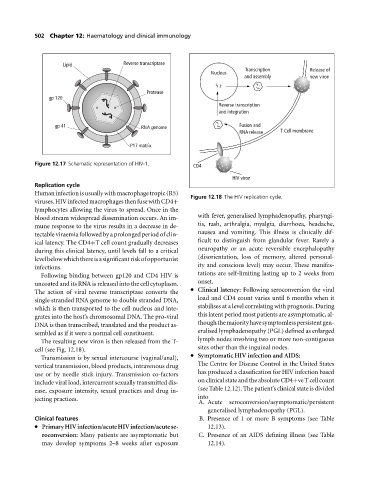Page 506 - Medicine and Surgery
P. 506
P1: KOA
BLUK007-12 BLUK007-Kendall May 12, 2005 20:37 Char Count= 0
502 Chapter 12: Haematology and clinical immunology
Lipid Reverse transcriptase
Transcription Release of
Nucleus
and assembly new viron
Protease
gp 120
Reverse transcription
and integration
gp 41 RNA genome Fusion and
RNA release T Cell membrane
P17 matrix
Figure 12.17 Schematic representation of HIV-1.
CD4
HIV viron
Replication cycle
Human infection is usually with macrophage tropic (R5)
Figure 12.18 The HIV replication cycle.
viruses.HIVinfectedmacrophagesthenfusewithCD4+
lymphocytes allowing the virus to spread. Once in the
with fever, generalised lymphadenopathy, pharyngi-
blood stream widespread dissemination occurs. An im-
mune response to the virus results in a decrease in de- tis, rash, arthralgia, myalgia, diarrhoea, headache,
tectable viraemia followed by a prolonged period of clin- nausea and vomiting. This illness is clinically dif-
ical latency. The CD4+Tcell count gradually decreases ficult to distinguish from glandular fever. Rarely a
during this clinical latency, until levels fall to a critical neuropathy or an acute reversible encephalopathy
levelbelowwhichthereisasignificantriskofopportunist (disorientation, loss of memory, altered personal-
infections. ity and conscious level) may occur. These manifes-
Following binding between gp120 and CD4 HIV is tations are self-limiting lasting up to 2 weeks from
uncoated and its RNA is released into the cell cytoplasm. onset.
Clinical latency: Following seroconversion the viral
The action of viral reverse transcriptase converts the
single stranded RNA genome to double stranded DNA, load and CD4 count varies until 6 months when it
which is then transported to the cell nucleus and inte- stabilises at a level correlating with prognosis. During
grates into the host’s chromosomal DNA. The pro-viral this latent period most patients are asymptomatic, al-
DNA is then transcribed, translated and the product as- thoughthemajorityhavesymptomlesspersistentgen-
sembled as if it were a normal cell constituent. eralised lymphadenopathy (PGL) defined as enlarged
The resulting new viron is then released from the T- lymph nodes involving two or more non-contiguous
cell (see Fig. 12.18). sites other than the inguinal nodes.
Symptomatic HIV infection and AIDS:
Transmission is by sexual intercourse (vaginal/anal),
The Centre for Disease Control in the United States
vertical transmission, blood products, intravenous drug
has produced a classification for HIV infection based
use or by needle stick injury. Transmission co-factors
on clinical state and the absolute CD4+veTcell count
include viral load, intercurrent sexually transmitted dis-
(see Table 12.12). The patient’s clinical state is divided
ease, exposure intensity, sexual practices and drug in-
into
jecting practices.
A. Acute seroconversion/asymptomatic/persistent
generalised lymphadenopathy (PGL).
Clinical features B. Presence of 1 or more B symptoms (see Table
PrimaryHIVinfection/acuteHIVinfection/acutese- 12.13).
roconversion: Many patients are asymptomatic but C. Presence of an AIDS defining illness (see Table
may develop symptoms 2–8 weeks after exposure 12.14).

